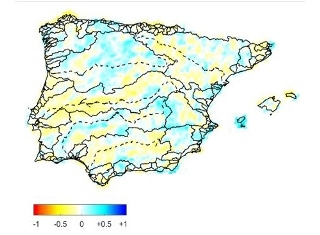Nov 30 2018
Scientists at Universidad Politécnica de Madrid (UPM) have identified the changes that are predicted to happen in maximum precipitations in the Iberian Peninsula and Balearics because of climate change. A statistical analysis of simulations of a possible future climate has resulted in a database that quantifies the predicted percentage changes in the maximum precipitations in the future according to varied emissions circumstances.
 Relative changes in annual maximum daily precipitation for a return period of 500 years in the Iberian Peninsula and the Balearics for the future period (2011-2040). (Image credit: Universidad Politécnica de Madrid)
Relative changes in annual maximum daily precipitation for a return period of 500 years in the Iberian Peninsula and the Balearics for the future period (2011-2040). (Image credit: Universidad Politécnica de Madrid)
These results have been applied to the review of the Preliminary Flood Risk Assessment conducted by the Ministry for the Ecological Transition to adapt it to the Flood Directive of the European Union.
According to Carlos Garijo, a scientist involved in this research: “Flood risks are expected to increase in the future as a consequence of climate change. Thus, the update of the Preliminary Flood Risk Assessment aims to identify at a national level the areas where are expected to increase the risks of flood due to climate change and to take measures to minimize the adverse consequences in these areas”.
Variations in flood patterns can happen as a consequence of natural disparities in climate, for example, differences in precipitation regimes and temperature, also as a consequence of human activities such as the construction of hydraulic infrastructures or the variation of land use. So as to understand how the influence of climate change will impact floods in the future, the primary step is to investigate how extreme precipitation will vary since they are commonly responsible for these floods.
With this perspective, scientists from the Hydroinformatics and Water Management Group at Universidad Politécnica de Madrid have explored the effect of climate change on maximum precipitations. To judge the future behavior of climate, scientists used the results of twelve climate models and identified the predicted changes in daily maximum precipitation in the Iberian Peninsula and Balearics.
Consequently, a database has been protected in the Intellectual Property Registry and includes the estimated percentages changes in the maximum precipitations for during future periods (2011-2040; 2041-2070; 2071-2100) and two likely scenarios of future greenhouse emissions.
The Ministry of Ecological Transition and the companies involved the review of the Preliminary Flood Risk Assessment have made use of these results to adapt it to the Flood Directive of the European Union that includes the impact of climate change on floods.
The database generated allows us to easily obtain the magnitude of extreme weather in the future, thus this study is also useful for city councils and water supply and sanitation companies as well as engineering companies that carry out studies considering the influence of climate change in extreme events.
Luis Mediero, Scientist, Universidad Politécnica de Madrid.